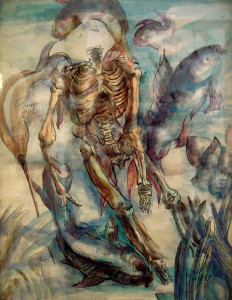by Don LaCoss
Egyptian surrealism broke above ground in late 1937 in Cairo, midwifed through the efforts of Georges Henein, Ramsīs Yūnān, Kāmil al-Tilmisāni, and the brothers Fu’ad and Anwar Kāmil. Throughout the Second World War, the group attracted the involvement of native Egyptians and European expatriates; they propagated a program for the revolutionary defense of the imagination, free expression, and social freedom. Their approach was consistent with ever other surrealist group in the world: a challenging blend of libertarian anti-capitalism, Freudian theories of the unconscious, and wild, poetic subversions of the sort found in the pages of Rimbaud and Lautréamont.
Continue reading ART AND LIBERTY: SURREALISM IN EGYPT
